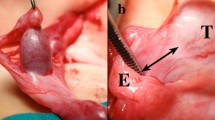Abstract
In the course of 1195 operations, performed in children with cryptorchidism, the testes were studied for size, turgor and fusion with the epididymis. Inquiries were made into the reasons of fusion disorders which were conspicuously numerous. Attention is called to this not too familiar condition which seems to play an important role in the emergence of fertility disorders in men with congenital cryptorchidism.
Similar content being viewed by others
References
Atkinson, P. M.: A follow-up of surgically treated cryptorchid patients.J. Pediatr. Surg., 10, 115 (1975).
Bedford, J. M.: Anatomical evidence for the epididymis as the prime mover in the evolution of the scrotum.Am. J. Anat., 152, 483 (1978).
Bidlingmaier, F., Dörr, H. G., Eisenmenger, W., Kuhnle, U., Knorr, D.: Testosterone and androstenedione concentrations in human testis and epididymis during the first two years of life.J. Clin. Endocrinol. Metab., 57, 311 (1983).
Conolly, N. K.: Maldescent of the testis.Am. J. Surg., 27, 405 (1959).
Elder, J. S., Isaacs, J. T., Walsh, P. C.: Androgenic sensitivity of the gubernaculum testis. Evidence for hormonal/mechanical interactions in testicular descent.J. Urol., 127, 1701 (1982).
Farrer, J. H., Sikka, S. C., Xie, H. W., Constantinidine, D., Rajfer, J.: Impaired testosterone biosynthesis in cryptorchidism.Fertil. Steril., 44, 125 (1985).
Gray, S. W., Skandalakis, J. E.: Embryology for surgeons. W. B. Saunders Co., Philadelphia-London-Toronto 1972.
Gross, R. E., Jewett, T. C. Jr.: Surgical experiences from 1222 operations for undescended testis.JAMA, 160, 634 (1956).
Hadžiselimović, F., Kruslin, E.: The role of epididymis in descensus testis and the topographical relationship between the testis and epididymis from the sixth month of pregnancy until immediately after birth.Anat. Embryol., 155, 191 (1979).
Hadžiselimović, F.: Mechanism of testicular descent.Urol. Res., 12, 155 (1984).
Hadžiselimović, F., Hecker, E., Herzog, B.: The value of testicular biopsy in cryptorchidism.Urol. Res., 12, 171 (1984).
Hadžiselimović, F.: Cryptorchidie. Pathogenie et histologie.Ann. Urol., 18, 240 (1984).
Heath, A. L., Mau, D. W. K., Eckstein, H. B.: Epididymal abnormalities associated with maldescent of the testis.J. Pediatr. Surg., 19, 47 (1984).
Hecker, W. C., Hienz, H.: Cryptorchidism and fertility.J. Pediatr. Surg., 2, 513 (1967).
Kirby, R. S., Chapple, C. R., Ward, S. P., Williams, C.: Is the scrotal testis normal in unilateral cryptorchidism?Br. J. Urol., 57, 187 (1985).
Madersbacher, H., Kövesdi, S., Frick, J.: Fertility in unilateral cryptorchidism.Urologie, 11, 210 (1972).
Marshall, F. F., Shermata, D. W.: Epididymal abnormalities associated with undescended testis.J. Urol., 121, 341 (1979).
Merksz, M.: Evolution and developmental disorders of the testis (in Hungarian).Gyermekgyógyászat, 28, 375 (1977).
Mininberg, D. T., Schlossberg, S.: The role of the epididymis in testicular descent.J. Urol., 129, 1207 (1983).
Molnár, J., Schirren, C.: Der Genitalbefund bei andrologischen Patienten. II. Hodengrösse und Spermiogrammbefund.Andrologie, 2, 3 (1970).
Papp, Gy., Lantos, J., Molnár, J.: Orchidopexie und Fertilität.Z. Urol. Nephrol., 74, 541 (1981).
Patten, B. M.: Human Embryology. McGraw-Hill Book Company, New York 1976.
Sohval, A. R.: Testicular dysgenesis as an etiological factor in cryptorchidism.J. Urol., 72, 693 (1954).
Scorer, C. G., Farrington, G. H.: Histological studies of the undescended testis. In: Congenital Deformities of the Testis and Epididymis. Butterworths, London 1971.
Tóth, J.: Conditions and consequences associated to abnormalities of testicular development. Chances of treatment (in Hungarian).Gyermekgyógyászat, 28, 381 (1977).
Tóth, J.: Paediatric Urology in Basic Therapy (in Hungarian). Medicina, Budapest 1986.
Wyndham, N. R.: A morphological study of testicular descent.J. Anat., 77, 179 (1943).
Author information
Authors and Affiliations
Rights and permissions
About this article
Cite this article
Merksz, M., Tóth, J. Testicular-epididymal fusion abnormality in undescended testis. International Urology and Nephrology 19, 179–187 (1987). https://doi.org/10.1007/BF02550471
Received:
Issue Date:
DOI: https://doi.org/10.1007/BF02550471




